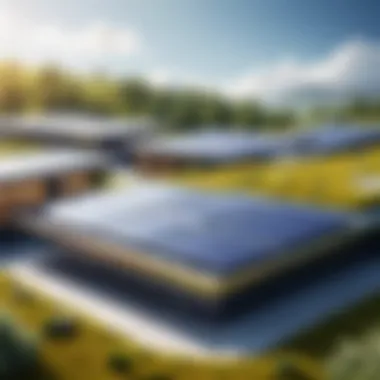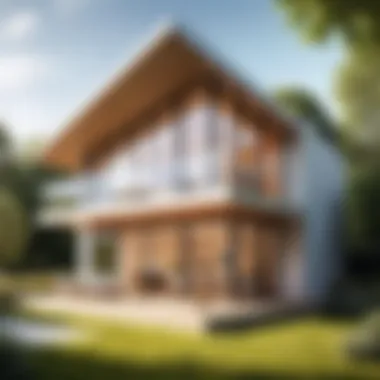Building It Green: Strategies for Sustainable Construction


Intro
In today’s world, the construction industry plays a critical role in shaping our living spaces and communities. The shift towards sustainable practices is not just a trend; it is a necessity. Building green encompasses a wide array of strategies aimed at reducing the environmental impact of construction projects while promoting energy efficiency and resource conservation. As professionals and enthusiasts in the fields of technology and design tap into this framework, they reshape the future of the built environment.
The stakes are high. As climate change intensifies, regulatory pressures grow, and public awareness of environmental issues rises, the construction sector must adopt innovative measures. This article explores sustainable construction methods, materials selection, energy efficiency, and lifecycle assessments. Each of these facets contributes uniquely to fostering a greener habitat.
Looking ahead, the integration of technology within these realms is pivotal. From the adoption of advanced materials to harnessing smart systems, maintaining a balance between functionality and sustainability becomes a central theme. As strategies evolve, so too does the understanding of what it means to build responsibly.
This discourse serves as both a comprehensive overview of existing practices and a guide for future advancements in green building initiatives.
Prelims to Green Building
The realm of construction is undergoing a significant transformation, fueled by a growing awareness of sustainability and the environmental impacts of traditional building methods. This shift is particularly relevant as climate change poses serious threats to our ecosystems and livelihoods. Understanding the principles of green building is imperative for professionals and enthusiasts alike to navigate this evolving landscape.
Green building is not merely a trend but a necessity that emphasizes the responsible use of resources. In this article, we explore various dimensions of sustainable construction, encompassing material selection, energy efficiency, and lifecycle assessment. This approach aims to provide both foundational knowledge and practical strategies to foster environmentally responsible architecture.
Incorporating sustainable practices doesn't just address environmental concerns; it also offers a multitude of benefits such as improved energy efficiency, reduced operational costs, and enhanced quality of life. As we delve into the various facets of green building, it's crucial to recognize that implementing sustainable methods can enhance the long-term viability of projects while safeguarding our planet for future generations.
Defining Green Building
Green building refers to the design, construction, and operation of structures that are environmentally responsible and resource-efficient throughout their lifecycle. This encompasses the planning stages, selection of materials, construction practices, operation, and maintenance. Key elements include reducing the consumption of energy and water, minimizing carbon footprints, and ensuring indoor environmental quality.
Green building practices often adhere to established frameworks and standards designed to assess and certify the sustainability of structures. LEED certification, for example, is a widely recognized benchmark reflecting a building's efficiency in energy use, water conservation, and sustainable materials sourcing.
Importance of Sustainable Practices
Sustainable practices are critical in today’s context. They help mitigate the adverse effects of climate change, conserve resources, and promote healthier ecosystems. The significance of sustainable construction can be analyzed through several perspectives:
- Environmental Impact: Implementing green building techniques reduces pollution, conserves natural resources, and promotes biodiversity.
- Economic Viability: While some perceive sustainability as a costly investment, it often yields substantial long-term savings through reduced energy and resource consumption.
- Social Responsibility: Adopting sustainable practices encourages community engagement and fosters the development of affordable housing, enhancing overall social wellbeing.
"Sustainability is no longer just a buzzword; it's a guiding principle that shapes the future of construction."
By emphasizing sustainability, we not only meet current demands but also contribute to a more resilient and adaptable future.
Principles of Sustainable Design
Sustainable design focuses on minimizing negative impacts on the environment while maximizing benefits to society. The principles behind sustainable design apply to all aspects of construction and architecture. They guide decisions that reinforce environmental responsibility. Understanding these principles is crucial in promoting sustainable construction practices.
Environmental Impact
Carbon Footprint
The carbon footprint represents the total greenhouse gases emissions caused directly and indirectly by an individual, organization, or product. In sustainable construction, reducing the carbon footprint is vital. Building operations often account for a significant portion of total carbon emissions in urban areas. Prioritizing materials and methods that lower these emissions can enhance a project's sustainability. Using low-carbon materials, improving energy efficiency, and optimizing transport logistics are key strategies. Many stakeholders view reducing carbon footprints as an effective way to address climate change.
Biodiversity
Biodiversity refers to the variety of life in a given ecosystem. Preserving biodiversity is essential in sustainable design practices. Construction often disrupts ecosystems. Careful planning can minimize habitat loss and species extinction. Incorporating native plants and maintaining wildlife corridors can promote biodiversity in built environments. A significant feature of biodiversity efforts is that they often reconnect urban developments with nature, leading to healthier living spaces.
Social Responsibility
Community Engagement
Engaging with the community during the planning and construction phases fosters social responsibility in sustainable design. Community input can shape projects that meet local needs. This approach allows for more culturally relevant and accepted developments. The processes often enhance public trust and can reduce opposition to projects. Well-engaged communities typically show higher satisfaction and support for sustainable initiatives.
Affordable Housing
Affordable housing is a critical aspect of social responsibility in sustainable design. High living costs often push vulnerable populations to the fringes of urban areas, leading to social disparity. Implementing affordable housing solutions addresses this issue. These projects can use sustainable materials and designs that keep costs low. The challenge lies in balancing affordability with high-quality, sustainable construction. Achieving this balance is crucial for long-term community stability.
Economic Viability
Cost-Benefit Analysis
Cost-benefit analysis is a systematic approach to estimating the strengths and weaknesses of alternatives. In sustainable construction, this analysis helps determine the economic feasibility of green practices. It considers initial costs, potential savings, and societal benefits. Using this method, stakeholders can make informed decisions that align financial goals with sustainable objectives. One challenge is accurately predicting long-term savings to justify initial investments.
Long-Term Savings
Long-term savings in sustainable design often result from reduced energy and maintenance costs. Implementing energy-efficient systems can lead to significant savings over time. However, calculating these savings requires forecasting future energy prices and technological advancements. Stakeholders are increasingly recognizing the importance of these long-term savings. They realize that investing in sustainable practices can yield financial benefits while promoting environmental stewardship.
Sustainable design merges economic viability with ecological and social considerations, showing that progress can be balanced.


Innovative Building Materials
Innovative building materials play a crucial role in the landscape of sustainable construction. They not only reduce environmental impact but also enhance the efficiency and longevity of structures. The choice of materials can influence energy consumption, maintenance needs, and the overall carbon footprint of a building. Thus, understanding and utilizing innovative materials is imperative for professionals in architecture and construction. The benefits of these materials often extend beyond the construction phase, as they contribute to energy savings and a smaller ecological footprint over time.
Recycled and Repurposed Materials
Using recycled and repurposed materials has increasingly become a core strategy in sustainable construction. These materials help divert waste from landfills and minimize the demand for new resources. Items like reclaimed wood, recycled metal, and repurposed bricks are not only environmentally friendlier but can also bring unique character and history to a building. For example, bricks made from prior construction projects can cut down on the energy needed to produce new bricks, as well as reduce greenhouse gas emissions.
Choosing to incorporate these materials demands careful attention to quality and safety standards. It is essential to ensure that recycled materials meet building codes and are free from contaminants. The ongoing challenge for many is balancing aesthetics, regulations, and the environmental benefits associated with these materials.
Green Sealers and Paints
Green sealers and paints are another vital component of innovative building materials. These products minimize harmful emissions and improve indoor air quality compared to traditional options. Many green sealers use water as a base instead of solvents, which decreases volatile organic compounds (VOCs) that can be detrimental to health and the environment.
Opting for these eco-friendly options not only aids in health aspects but also aligns with the growing consumer demand for sustainable living spaces. When selecting green sealers and paints, consider certifications such as Green Seal and the Environmental Choice Program, which can be indicators of environmental compliance and product performance.
Sustainable Insulation Options
Insulation is essential in maintaining energy efficiency in buildings. Sustainable insulation options vary from natural materials to innovative synthetic alternatives. For instance, cellulose insulation, made from recycled paper, is gaining popularity as it offers excellent thermal resistance and is often treated to resist pests.
Another noteworthy material is spray foam insulation. While it is a synthetic choice, many manufacturers produce low-emission versions that cut down on chemical impacts commonly associated with traditional foam insulations.
The choice of insulation should hinge upon its performance, ecological footprint, and cost. Researching and evaluating insulation materials based on thermal properties, sustainability, and cost-effectiveness can lead to better building performance and lower energy bills over the structure's lifecycle.
Energy Efficiency in Construction
Energy efficiency plays a crucial role in sustainable construction. It focuses on reducing energy consumption in both the construction phase and the operational phase of buildings. The importance of efficient energy use not only aids in diminishing greenhouse gas emissions but also provides economic benefits through reduced energy bills. Moreover, energy-efficient strategies improve indoor environmental quality, which contributes to better health and wellbeing for occupants.
The integration of energy efficiency into construction practices involves several considerations such as the type of energy systems utilized, insulation material selection, and the implementation of renewable energy sources. A well-designed energy-efficient building can lead to considerable savings over its lifecycle, making a compelling case for investment in these strategies.
Energy Modeling Software
Energy modeling software is an essential tool for predicting energy performance in buildings. This technology allows architects and engineers to simulate various design scenarios and assess the energy use implications of different materials and systems. Users can input specific parameters to create models that closely resemble the eventual construction.
One of the main benefits of using energy modeling software is its ability to identify inefficiencies early in the design process. By employing this software, stakeholders can make informed decisions, ensuring that projects meet energy efficiency requirements effectively.
Passive Design Strategies
Orientation
Orientation refers to the placement of a building in relation to the sun's path. This factor significantly influences natural lighting and temperature control in the structure. By optimizing orientation, designers can harness sunlight for heating during winter while minimizing overheating in summer. This leads to substantial energy savings.
A key characteristic of proper orientation is its simplicity. It does not require advanced technologies but relies on strategic design principles. Its unique feature is the natural regulation of temperature through sunlight exposure, making it a popular choice for reducing reliance on mechanical heating and cooling. One potential disadvantage is that geographical limitations may affect the ideal orientation.
Natural Ventilation
Natural ventilation utilizes wind and temperature differences to enhance air circulation within a building. This method can significantly decrease the need for mechanical cooling systems and improve indoor air quality. Its key characteristic is that it relies on environmental forces, which makes it a sustainable and cost-effective strategy.
The unique feature of natural ventilation lies in its ability to maintain comfortable indoor conditions without the need for energy-intensive systems. This attribute is particularly beneficial in moderate climates where external conditions are often conducive to natural airflow. However, natural ventilation may not be as effective in extreme weather conditions, which requires careful consideration during design.
Renewable Energy Integration
Solar Panels
Solar panels convert sunlight into electricity. They are a cornerstone of energy-efficient structures, allowing buildings to reduce grid reliance and lower operating costs. A key characteristic of solar panels is their versatility, as they can be integrated into a variety of building designs on rooftops or even as building-integrated photovoltaics.
Their unique feature includes the ability to provide energy during peak sunlight hours, which aligns well with increasing energy demand. While the initial expenditure for solar panels can be high, the long-term benefits and energy savings often outweigh these costs.
Wind Energy Solutions
Wind energy solutions harness the kinetic energy from wind to generate electricity. They are particularly beneficial for buildings located in areas with favorable wind conditions. A key characteristic of wind energy systems is their scalability, allowing for various sizes of installations based on energy needs.
The unique feature of wind energy solutions is their ability to supply renewable power consistently, in addition to solar energy where conditions allow. However, the intermittent nature of wind may cause dependency on supplementary energy sources, thus requiring a well-planned energy system integration to ensure reliability.
"Investing in energy-efficient construction is not merely an environmental consideration but also a financial strategy with long-term returns."
Incorporating these energy efficiency strategies not only aligns with sustainable construction goals but also enhances the value and functionality of buildings.
Water Conservation Techniques


Water conservation is crucial in sustainable construction. The building sector requires substantial water for various processes, from construction to daily operations after completion. By prioritizing water-saving techniques, we can mitigate the strain on local water resources, promote sustainability, and enhance the ecological integrity of a watershed. Companies and homeowners alike benefit from these practices through reduced utility bills and resilience to water shortages.
Rainwater Harvesting Systems
Rainwater harvesting involves collecting and storing rainwater for reuse. This system can be integrated into new constructions or retrofitted into existing buildings. The benefits of rainwater harvesting are noteworthy. First, it reduces dependence on municipal water supplies. This is especially valuable in areas facing drought or water scarcity. Moreover, utilizing rainwater decreases stormwater runoff, which can lead to erosion and water pollution.
Setting up a rainwater collection system often includes gutters, downspouts, and storage tanks. These systems can be designed to collect water from rooftops, leading to efficient management of rainwater. The collected water has multiple uses, such as irrigation for gardens, flushing toilets, and laundry.
In many places, installing rainwater systems can also qualify for tax incentives, which makes it an appealing choice for property owners.
Low-Flow Fixtures and Fittings
Low-flow fixtures are another effective strategy for water conservation in green building. These fixtures include showerheads, faucets, and toilets designed to use significantly less water compared to standard options. For instance, low-flow showerheads can use around 1.5 to 2.0 gallons per minute (GPM), as opposed to the traditional 2.5 GPM or more.
The advantages of installing low-flow fixtures extend beyond mere water savings. They also lead to lower energy costs since less hot water is required, benefiting both the environment and the wallet. Furthermore, these fixtures are often inexpensive and easy to install, making them accessible to a broad audience.
Xeriscaping Principles
Xeriscaping refers to landscaping that reduces or eliminates the need for irrigation. This method is particularly suited for regions experiencing prolonged periods of drought or where water resources are limited. The principles of xeriscaping include selecting native and drought-tolerant plants that thrive in local conditions, minimizing lawn areas, and using mulch to retain soil moisture.
In addition to conserving water, xeriscaping promotes biodiversity by creating habitats that support local wildlife. It also demands less maintenance, as native plants often require fewer resources than non-native species. This approach leads to eco-friendly environments while still providing aesthetically pleasing landscapes for homes and communities.
"Adopting water conservation techniques not only sustains our environment but also ensures a responsible use of resources for future generations."
Water conservation techniques serve as foundational strategies in sustainable construction, yielding both immediate and long-term benefits for individuals and the ecosystem. By implementing rainwater harvesting systems, low-flow fixtures, and xeriscaping, we can make meaningful contributions to environmental stewardship.
Lifecycle Assessment in Green Building
Lifecycle assessment (LCA) plays a crucial role in the realm of green building. Understanding the entire environmental impact of construction projects requires a comprehensive examination. LCA enables stakeholders to evaluate the probable effects of materials, processes, and design choices over the lifespan of a building. This process not only pinpoints areas for improvements but also allows for more informed decisions that follow sustainability principles.
Understanding Lifecycle Assessment
Lifecycle assessment is essentially a systematic approach for evaluating the impacts associated with all stages of a product's life. This includes extraction of resources, production, transportation, usage, and disposal. Each phase presents unique challenges and opportunities for sustainability. By examining each stage, builders and architects can identify significant environmental hot spots.
LCA typically starts with defining the goal and scope of the assessment. After that, it involves a detailed inventory analysis, where inputs and outputs of each construction phase are quantified. Then, the impact assessment follows, which evaluates the potential environmental effects based on the collected data. Lastly, interpretation of results gives insights on how to improve future building practices.
Assessing Environmental Impact
Assessing the environmental impact is a key component of LCA. It enables professionals to see how construction choices affect the environment. For example, materials sourced locally usually have a lower carbon footprint compared to those transported long distances. This touches on vital aspects such as:
- Resource Consumption: Understanding the amounts of energy and materials used
- Emissions: Tracking greenhouse gases emitted versus absorbed
- Biodiversity Effects: Assessing how construction disrupts local ecosystems
When applying these assessments, the goal is to encourage practices that minimize negative impact. The insights gained from assessing environmental impacts can drive innovations in material selection, optimizing energy use, and improving waste management practices during and after construction.
Integrating Life Cycle Thinking
Integrating life cycle thinking in construction design involves considering long-term impacts rather than short-term benefits. This requires a shift in mindset for many stakeholders who may be focused solely on immediate costs. By adopting this approach, the overall sustainability of the building increases significantly.
Life cycle thinking encourages:
- Holistic Project Planning: Considering all phases early in the design process
- Material Choices: Opting for products that have lower overall impacts
- Longer Usage: Designing for durability and adaptability over time
This perspective not only leads to more sustainable buildings but also fosters innovation across industry practices. Stakeholders who embrace life cycle thinking gain a competitive edge, appealing to an increasingly eco-conscious market.
"Implementing lifecycle assessment is not just about compliance; it is about reimagining building practices for a sustainable future."
Regulatory Frameworks and Standards
Regulatory frameworks and standards serve as vital components in sustainable construction. They create a guideline for environmentally responsible building practices, ensuring that projects adhere to legal, safety, and environmental standards. These frameworks can foster innovation, safeguard public interests, and promote sustainable methods throughout the construction lifecycle.
LEED Certification
LEED, or Leadership in Energy and Environmental Design, is one of the most recognized green building certification systems globally. It provides a framework that encourages sustainable practices in design, construction, and operational phases.
Achieving LEED certification requires meeting certain prerequisites and credits across various categories, including energy efficiency, water usage, and materials selection. The benefits of obtaining LEED status are manifold:
- Enhanced Marketability: Buildings with LEED certification often attract tenants willing to pay a premium for green features.
- Operational Cost Savings: Efficient resource management leads to lower utility bills over time.
- Environmental Impact: LEED-certified buildings typically have reduced carbon footprints and contribute less to pollution.
By promoting these standards, the construction industry can shift towards a more sustainable future.


Building Codes and Policies
Building codes and policies are essential in enforcing safety and sustainability. These regulations dictate how buildings should be constructed and maintained. They address various factors such as structural integrity, fire safety, and energy efficiency.
In many jurisdictions, building codes are evolving to incorporate environmentally friendly practices. This include:
- Energy Standards: Lowering overall energy consumption requirements.
- Sustainable Materials Use: Encouraging the use of materials that do not harm the environment.
- Waste Management Protocols: Establishing guidelines for reducing construction waste.
Although compliance can be viewed as cumbersome, adhering to these standards ensures safer buildings and encourages builders to incorporate new technologies and methods that support sustainability.
Incentives for Green Building
Incentive programs play a critical role in motivating developers and builders to adopt green practices. These incentives can take various forms, such as:
- Tax Credits: Financial reductions can significantly lower the costs associated with sustainable building.
- Grants and Rebates: These support upfront costs for implementing energy-efficient technologies.
- Zoning Preferential Treatment: Offering more favorable zoning allowances for green projects.
Such incentives not only promote sustainable practices but also demonstrate that governments are actively supporting the transition to eco-friendly construction. By offering financial motivation, regulatory bodies can help facilitate a greater commitment to sustainability in the industry.
"Adhering to regulations and standards is not just about compliance, it's about paving the way for responsible innovation in the building sector."
Integrating regulatory frameworks and standards into sustainable construction practices fosters a collective movement towards a greener future, balancing economic, social, and environmental considerations.
Challenges in Sustainable Construction
The journey towards sustainable construction is fraught with significant challenges that require careful consideration. In this section, we discuss the major setbacks faced by professionals in the green building sector. Understanding these obstacles is essential to devising strategic solutions that effectively guide the industry toward more sustainable practices.
Cost-Related Barriers
Cost is a principal barrier in the adoption of sustainable construction methods. Initial investments for green building materials and technologies are often substantially higher than traditional options. For instance, utilizing sustainable insulation or renewable energy systems like solar panels can require a larger upfront cost.
Many investors and builders worry that these costs will not be recouped over time through savings on utility bills or through increased property values. Despite potential long-term savings, the reluctance to invest upfront remains a critical challenge. This highlights the importance of educating stakeholders about the benefits of life-cycle savings to justify initial expenditures.
Market Readiness
Market readiness is another hurdle affecting sustainable construction. There is often a lag in the acceptance of green products and technologies among consumers and contractors. Even with a growing awareness of environmental concerns, the demand for sustainable building materials and practices can vary significantly by region.
Some markets are better equipped than others to support green initiatives. Technological innovations also require time for widespread adoption. Moreover, traditional practices are deep-rooted in many construction firms, making a shift to sustainable methodologies difficult. There is a clear need for more robust market research and outreach to effectively promote green options.
Regulatory Compliance Issues
Compliance with evolving regulations can pose a considerable challenge for sustainable construction. Building codes can be restrictive, and they may not always sync with green practices. Navigating this complex regulatory landscape requires expertise and constant vigilance. Many builders find it difficult to keep up with local, state, and federal regulations that can change frequently.
Moreover, the lack of standardized regulations at a national level can lead to confusion and inconsistency in sustainable construction practices. To mitigate this, firms must establish internal compliance strategies and stay informed about relevant laws and standards. Engaging with regulatory bodies could also foster better alignment between sustainable practices and legal requirements.
Understanding the challenges in sustainable construction is critical. Overcoming these barriers can pave the way for more effective green building strategies that benefit both the industry and the environment.
Future of Green Building
The future of green building is a pivotal topic in the discussion of sustainable construction. As environmental concerns escalate, the demand for eco-conscious practices in the construction sector intensifies. Future building strategies must not only address current ecological challenges but also anticipate upcoming needs. These considerations include improving resource efficiency, reducing waste, and adapting to the realities of a changing climate.
The trend toward greener construction is driven by several elements. Firstly, the integration of advancing technology promises to enhance the effectiveness of green building practices. Moreover, global trends, such as urbanization and climate change adaptation, necessitate a shift in how buildings are designed, constructed, and operated. Given these dynamics, understanding the future of green building is essential for tech-savvy audiences seeking effective solutions and innovations.
Technological Advancements
Technological advancements are core to transforming green building practices. Innovations in building materials, energy management systems, and automated construction techniques pave the way for more sustainable projects. For example, smart building technologies enable real-time monitoring of energy usage. These systems help optimize performance and reduce energy waste. The evolution of materials science also leads to products that are both eco-friendly and resilient, thus supporting an increasingly sustainable approach to construction.
Moreover, advancements in data analytics and artificial intelligence can improve project planning and efficiency. Implementing these technologies not only maximizes resource usage but also shortens construction timelines, ultimately benefiting the economy as a whole.
Global Trends and Shifts
Urbanization
Urbanization presents both challenges and opportunities within the scope of green building. The increasing migration of populations to urban areas significantly affects building design and resource management. As cities expand, they often face heightened resource consumption and waste generation. Therefore, smart urban planning is essential to mitigate these effects.
A key characteristic of urbanization is the requirement for high-density housing. This encourages vertical building designs that can conserve land and reduce sprawl. Additionally, urban areas can facilitate public transport systems, which lower carbon emissions. However, the rapid pace of urbanization can strain infrastructure, presenting a disadvantage if not managed effectively. Thus, integrating sustainable practices in urban planning can yield substantial benefits, such as reduced environmental impact and enhanced quality of life for residents.
Climate Change Adaptation
Climate change adaptation is critical for ensuring the resilience of buildings in a changing environment. With more extreme weather patterns and rising sea levels, construction strategies must incorporate adaptive measures. Buildings that can withstand climate extremes not only protect inhabitants but also uphold community integrity.
A defining feature of climate change adaptation is the incorporation of flexible designs that can evolve with future conditions. For example, buildings located in flood-prone areas may necessitate elevated structures or flood-resistant materials. Such adaptations ensure that investments in construction are viable in the long term. However, it is important to balance adaptation strategies with overall cost-efficiency. When planned thoughtfully, climate adaptation enhances the sustainability of future structures, making it a wise approach to consider in green building discussions.
Collaborative Approaches in Design
Collaborative approaches in design foster innovation and inclusivity in sustainable construction practices. By bringing together architects, engineers, environmental scientists, and the community, projects can benefit from diverse perspectives. This cooperation can lead to creative solutions that address unique local challenges and maximize the environmental benefits of building initiatives.
Furthermore, collaboration extends beyond the planning phase; it involves ongoing partnerships throughout the lifecycle of the building. Engaging stakeholders at each step ensures that sustainability goals are aligned and effectively implemented. In this way, collaborative design becomes an integral part of translating green building objectives into actionable projects.







